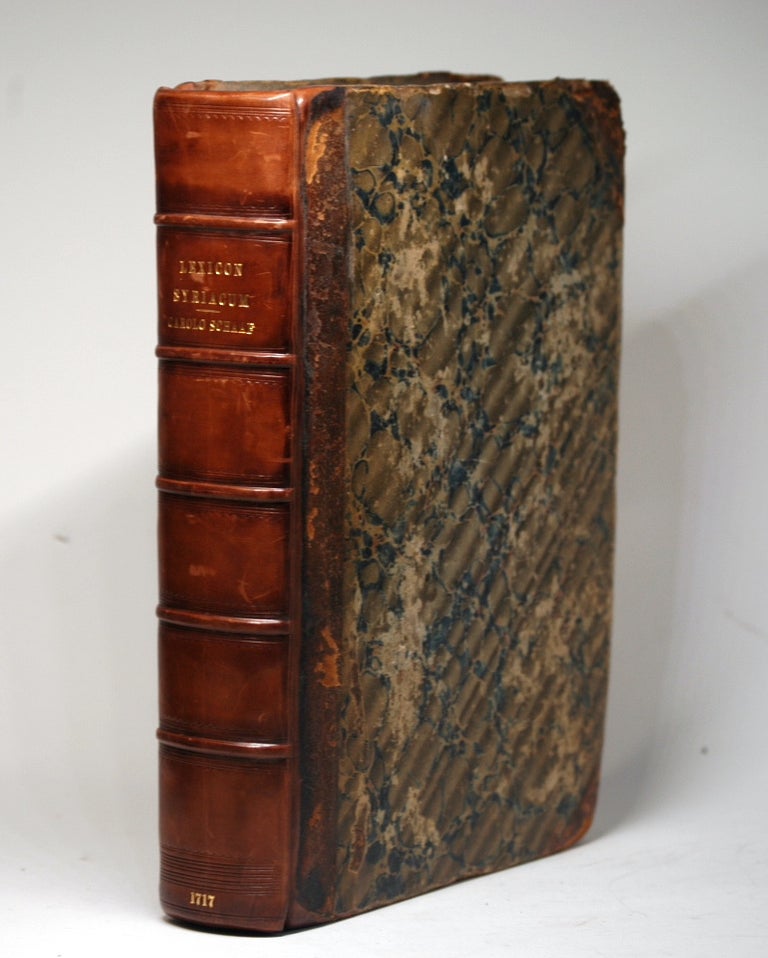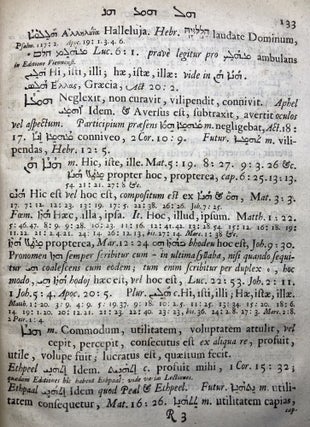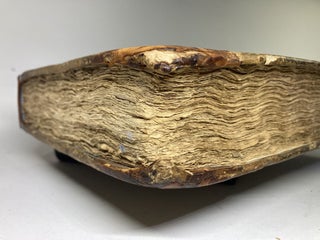LEXICON SYRIACUM CONCORDANTIALE, Omnes Novi Testamenti Syriaci Voces: Et ad Harum illustrationem multas alias Syriacas, & Linguarum Affinium dictiones Complectens, Cum necessariis Indicibus, Syriaco & Latino, Ut & Catalogo Nominum Propriorum ac Gentilium N.T. Syr.
J. Mulleri (Johann Muller), C. Boutesteyn, S. Luchtmans, 1717. Editio Secunda. Leather. [10], 644, [119 Index] pp. 4to, half brown calf over marbled paper-over-boards. Rebacked in matching brown calf with raised bands over six panels, blind ruled, gilt lettered, deckled edges, fresh endpapers; rag paper with all edges deckled. Fore tips are a bit rubbed and bruised, some superficial scratches to the new leather, otherwise very sound and handsome with nearly pristine internal text. Stereotyped second edition, exact replica of the first 1707 edition but for new title page. Notable early example of the (proto-) stereotype process by its inventor, Johann Muller, who 'found a way to make a matrix from a whole page of type, and to cast a metal copy of the page from it. The copy could then be used in a forme, and the type that had served as a pattern could be distributed to be used again' (Gnirrep, 'Standing type or stereotype in the seventeenth century,' 19). VERY GOOD. Item #1726
Karl Schaaf’s Syriac Lexicon is noteworthy for a few reasons. It offered an essential interpretive key to his edition of the Peshitta, which reigned as the standard text of the Syriac New Testament until 1905. Interest in Syriac had increased greatly in the 1700’s as the textual criticism work of the two prior centuries had thoroughly unsettled the originality of the received text of the Greek New Testament. The Syriac text was not simply a translation of the original, but in fact witnessed to now-lost original manuscripts with variant readings. Additionally, as the spoken language of Jesus and his 1st-century Palestinian contemporaries, the study of the nuances of Syriac expression yielded fresh insight into the understanding of the sacred text.
As second editions go, this particular one is noteworthy for being produced with the “Stereotype” method. For the first 250 odd years of printing, if a book sold well there there were two options for running a second printing. They could reset the type, a colossal outlay of time and labor. Or they could save they could just leave the set type in its forme (the frame holding a typeset page together). This latter option was much easier, but only an option for the largest of firms since movable type was very expensive and smaller firms might not have enough of it to allow it to be bound up while other projects waited.
Many printers had tinkered with the possibility of casting a mold of a complete forme (or “chase”) essentially creating a matrix for a full page of set type. Lutheran Minister Johann Muller, a Dutch printer operating in Leiden, was the first one to master this process in the first decade of the 1700’s. One of the first books to have its type preserved for a second edition with this new “Stereotype” method was Karl Schaaf’s Lexicon Syriacum Concordantiae in 1707.
The fallout from this new innovation was manifold: With the ability to preserve the type sheets for ready reprinting, printers did not have to risk such a large initial print run for every edition printed. The projected sales of a second edition could also be more modest with no further typesetting expense. It also meant that printers did not have to be as heavily capitalized for the outlay of many sets of type. They could have just one set of type and still capably handle a good number of titles per year.
Note: while even the revised edition of Steinberg’s 500 years of printing only allows that some unnamed Dutch publishers made rudimentary gestures toward an eventual German mastery of the stereotype method in the mid-century, it is well established that Muller was using stereotype to great effect, as witnessed by this Syriac Lexicon, printed from stereotype, in 1717. (See: Gnirrep, "Standing type or stereotype in the seventeenth century.”).
Price: $550.00





